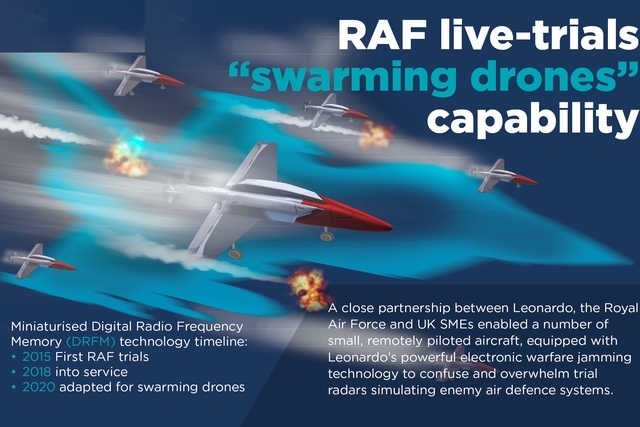Leonardo, RAF Demo Massive Electronic Attack Using Drone Swarms

Leonardo and the Royal Air Force’s Rapid Capabilities Office (RCO) have conducted a live trial of a massive electronic attack using a drone swarm.
During the demo, a number of small, remotely-piloted aircraft equipped with Leonardo’s electronic warfare jamming technology were used to confuse and overwhelm trial radars simulating enemy air defence systems.
During the demonstration, a number of Callen Lenz drones were equipped with a modified Leonardo BriteCloud decoy, allowing each drone to individually deliver a highly-sophisticated jamming effect. In addition, the decoy packages were programmed and navigated to work collaboratively to cause maximum confusion.
They were tested against ground-based radar systems representing the enemy air defence emplacement. A powerful demonstration was given, with the swarm of BriteCloud-equipped drones overwhelming the threat radar systems with electronic noise.
BriteCloud, which was originally developed as a high-tech protective decoy for combat jets, went into service with the RAF in 2018, marking another world-first for Leonardo and the RCO. Known generically as an Expendable Active Decoy (EAD), each BriteCloud round can individually mimic the radar signature of the aircraft it is launched from, causing threat radar systems to track the drinks -can-sized decoy rather than the aircraft itself.
The only product of its type now available worldwide, BriteCloud is available for UK allies to order and is currently undergoing evaluation by US Armed Forces.
Following a rapid cycle of development which saw the RCO and Leonardo’s engineers working together with UK SMEs Callen Lenz and Blue Bear, this live trial of the concept conducted by UK Armed Forces represents a key step towards proving an autonomous swarming drone capability.
The information gained from the demonstration will be used to inform potential future UK programmes to acquire an autonomous swarming drone capability.











